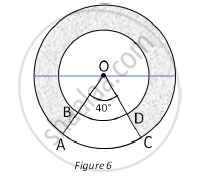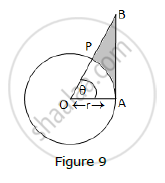Advertisements
Advertisements
Question
Find the circumference of the circle with the following radius: (Take `bb(pi = 22/7`)
14 cm
Solution
r = 14 cm
Circumference = 2πr
= `2 xx 22/7 xx 14`
= 88 cm
APPEARS IN
RELATED QUESTIONS
In Fig. 6, find the area of the shaded region, enclosed between two concentric circles of radii 7 cm and 14 cm where ∠AOC = 40°. (use `pi = 22/7`)

In Fig. 9, is shown a sector OAP of a circle with centre O, containing ∠θ. AB is perpendicular to the radius OQ and meets OP produced at B. Prove that the perimeter of shaded region is
`r[tantheta+sectheta+(pitheta)/180-1]`

An elastic belt is placed around the rim of a pulley of radius 5 cm. (Fig. 10) From one point C on the belt, the elastic belt is pulled directly away from the centre O of the pulley until it is at P, 10 cm from the point O. Find the length of the belt that is still in contact with the pulley. Also find the shaded area (use π = 3.14 and `sqrt3=1.73)`

The area of a circle inscribed in an equilateral triangle is 154 cm2. Find the perimeter of the triangle.
The perimeter of the quadrant of a circle is 25 cm. Find its area.
An express train is running between two stations with a uniform speed. If the diameter of each wheel of the train is 42 cm and each wheel makes 1200 revolutions per minute, find the speed of the train.
The radius of two circles are in the ratio 3 : 5, find the ratio between their circumferences.
The circumference of a circle is numerically equal to its area. Find the area and circumference of the circle.
The diameter of two circles are 28 cm and 24 cm. Find the circumference of the circle having its area equal to sum of the areas of the two circles.
In covering a distance s metres, a circular wheel of radius r metres makes `s/(2πr)` revolutions. Is this statement true? Why?
